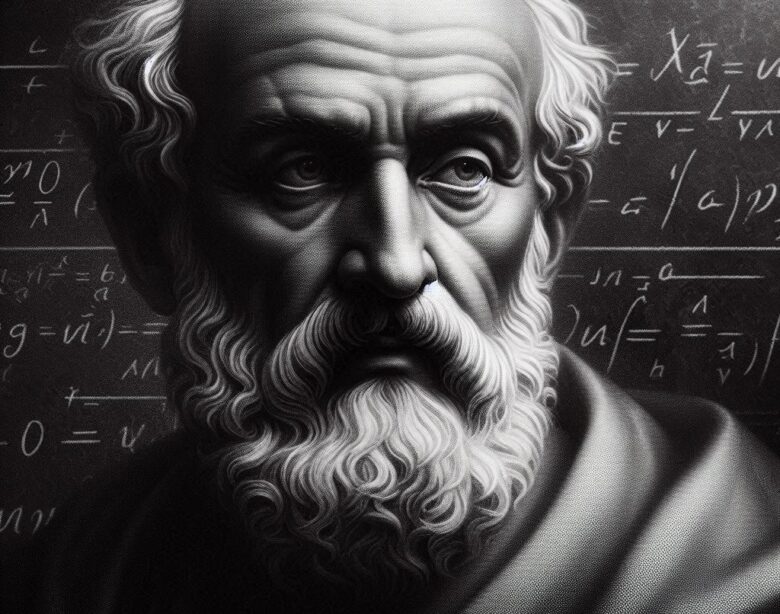Eratosthenes of Cyrene (circa 276 BCE–194 BCE) stands as one of the greatest minds of ancient Greece, making monumental contributions to mathematics, geography, astronomy, and more. Known for his innovative thinking and interdisciplinary approach, Eratosthenes earned the title of Pentathlos—a champion of many intellectual disciplines. As the chief librarian of the famed Library of Alexandria, Eratosthenes not only preserved knowledge but also created it, pioneering methods that would shape scientific inquiry for centuries. This blog post explores his life, his groundbreaking work, and the enduring impact of his ideas on the history of mathematics and science.
Eratosthenes’ Early Life and Education
Born in the Greek city of Cyrene (modern-day Libya), Eratosthenes received an education that emphasized broad intellectual exploration. He studied in Alexandria, then the intellectual epicenter of the ancient world, and later in Athens, where he delved into philosophy, mathematics, and astronomy.
Eratosthenes was a student of diverse fields, including literature and history, which complemented his scientific pursuits. This multidisciplinary background shaped his career, eventually earning him a position as the head of the Library of Alexandria. It was here, surrounded by the collected knowledge of the ancient world, that Eratosthenes made his most significant contributions.
Contributions to Mathematics
The Sieve of Eratosthenes
One of Eratosthenes’ most famous mathematical contributions is the Sieve of Eratosthenes, a simple yet efficient algorithm for finding all prime numbers up to a given limit. The algorithm works by systematically marking multiples of each prime number starting from 2, the smallest prime. Numbers that remain unmarked are prime.
This method was revolutionary in its simplicity and utility. It provided a systematic way to identify primes and remains a fundamental tool in number theory. Modern computer algorithms for generating primes often draw inspiration from this ancient technique, demonstrating its timeless value.
Geometry and Measurement
Eratosthenes was deeply interested in geometry, which played a crucial role in his scientific achievements. His understanding of geometric principles enabled him to solve problems in astronomy and geography. He used geometric methods to measure distances and angles, laying the groundwork for future mathematical explorations in spatial reasoning.
Contributions to Geography
Measuring the Circumference of the Earth
Perhaps Eratosthenes’ most famous achievement was his remarkably accurate calculation of the Earth’s circumference. He observed that at noon during the summer solstice, the Sun cast no shadow in the city of Syene (modern-day Aswan) because it was directly overhead. However, in Alexandria, located approximately 800 kilometers to the north, the Sun cast a shadow, indicating that it was not directly overhead.
By measuring the angle of the shadow in Alexandria (about 7.2 degrees) and knowing the distance between the two cities, Eratosthenes used simple geometry to estimate the Earth’s circumference. He reasoned that the 7.2-degree angle represented 1/50th of a full circle, so the Earth’s total circumference must be 50 times the distance between Syene and Alexandria.
Eratosthenes’ estimate of the Earth’s circumference was approximately 40,000 kilometers—astonishingly close to modern measurements. This achievement demonstrated not only the power of mathematical reasoning but also the effectiveness of applying interdisciplinary knowledge to solve complex problems.
Mapping the Known World
Eratosthenes also made significant contributions to cartography. He created one of the earliest maps of the known world, incorporating geographic information from travelers, explorers, and earlier scholars. His map included a system of latitude and longitude lines, which provided a framework for describing locations on Earth. This system influenced later geographers, including Claudius Ptolemy, and remains foundational in modern cartography.
Contributions to Astronomy
Eratosthenes’ work in astronomy complemented his geographical studies. He measured the tilt of the Earth’s axis with remarkable accuracy, calculating it to be about 23.5 degrees—very close to the modern value of 23.4 degrees. This measurement was crucial for understanding seasonal changes and the movement of celestial bodies.
He also estimated the distance from the Earth to the Sun and the Moon, laying the groundwork for later astronomers. His efforts to quantify celestial phenomena demonstrated a profound understanding of the interconnectedness of mathematics, geography, and astronomy.
Philosophy and Literature
Eratosthenes was not only a scientist but also a philosopher and literary scholar. He wrote extensively on the nature of knowledge, ethics, and education. His interdisciplinary approach reflected the ancient Greek ideal of the polymath, someone who excels in multiple fields of study.
In literature, Eratosthenes composed critical works that analyzed Greek poetry and history. Although many of his writings have been lost, their influence persisted through citations and references by later scholars. His ability to integrate scientific and humanistic disciplines set a standard for intellectual inquiry.
Legacy and Impact
Advancing Scientific Methods
Eratosthenes’ methods exemplified the scientific approach, combining observation, measurement, and logical reasoning. His ability to draw connections between seemingly disparate fields—such as using geometry to study the Earth’s size—was revolutionary. This interdisciplinary approach influenced later thinkers, including Renaissance scientists who sought to rediscover and build upon ancient knowledge.
Influence on Geography and Astronomy
Eratosthenes’ work in geography and astronomy laid the foundation for future scientific advancements. His measurement of the Earth’s circumference inspired explorers like Christopher Columbus, who relied on similar calculations (albeit with errors) to plan their voyages.
In astronomy, his calculations of celestial distances and axial tilt provided a framework for understanding the cosmos. These contributions influenced scholars such as Hipparchus and Ptolemy, who further developed astronomical models.
Mathematics as a Universal Tool
Through innovations like the Sieve of Eratosthenes, he demonstrated the power of mathematics as a universal tool for solving problems. His methods remain relevant in modern mathematics, computer science, and engineering.
Bridging Knowledge Across Disciplines
Eratosthenes’ interdisciplinary approach serves as a model for modern scholars. His ability to integrate mathematics, geography, astronomy, and philosophy underscores the value of a holistic perspective in advancing human knowledge.
Challenges and Limitations
While Eratosthenes’ achievements were groundbreaking, his reliance on available knowledge and tools limited his precision. For example, his measurement of the Earth’s circumference depended on the accuracy of distance estimates between cities, which could vary. Despite these limitations, his methods were remarkably innovative and demonstrated the potential for improvement through better data and tools.
Conclusion
Eratosthenes of Cyrene was a true pioneer whose contributions to mathematics, geography, astronomy, and philosophy left an indelible mark on human history. His ability to synthesize knowledge across disciplines exemplifies the timeless value of intellectual curiosity and interdisciplinary thinking. From measuring the Earth’s circumference to creating the Sieve of Eratosthenes, his innovations continue to inspire mathematicians and scientists today.
Eratosthenes’ legacy reminds us of the enduring power of inquiry and the importance of connecting ideas across fields to advance our understanding of the world. As a polymath of ancient Greece, he set a standard for intellectual achievement that continues to guide and inspire modern scholarship.
Please Visit Our Sponsors:
We only support vendors that we use ourselves in our home. The links below are our own links or affiliate links but know that we use all of these now, or have in the past. As the author/creator of this blog, I also tutor mathematics on Wyzant, sell on Etsy, create content on TpT, and learn Korean on Rosetta Stone.




